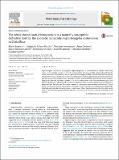| dc.contributor.author | Hagnauer, Isabel | |
| dc.contributor.author | Santoro, Mario | |
| dc.contributor.author | Alfaro-Alarcón, Alejandro | |
| dc.contributor.author | VENEZIANO, Vincenzo | |
| dc.contributor.author | Cerrone, Anna | |
| dc.contributor.author | Latrofa, Maria Stefania | |
| dc.contributor.author | Otranto, Domenico | |
| dc.contributor.author | Jiménez-Soto, Mauricio | |
| dc.date.accessioned | 2020-05-28T21:12:17Z | |
| dc.date.available | 2020-05-28T21:12:17Z | |
| dc.date.issued | 2016-09-15 | |
| dc.identifier.uri | http://hdl.handle.net/11056/17462 | |
| dc.description.abstract | Angiostrongylus costaricensis (Strongylida, Angiostrongylidae) is a roundworm of rodents, which may cause a severe or fatal zoonosis in several countries of the Americas. A single report indicated that the white-nosed coati (Nasua narica), acts as a potential free-ranging wildlife reservoir. Here we investigated the prevalence and features of A. costaricensis infection in two procyonid species, the white-nosed coati and the raccoon (Procyon lotor) from Costa Rica to better understand their possible role in the epidemiology of this zoonotic infection. Eighteen of 32 (56.2%) white-nosed coatis collected between July 2010 and March 2016 were infected with A. costaricensis but none of 97 raccoons from the same localities were diagnosed with this infection. First-stage larvae of A. costaricensis were obtained from feces of 17 fresh white-nosed coati carcasses by Baermann technique. Parasite identity was confirmed by morphology, histology and molecular characterization of target genes. These data demonstrate that the white-nosed coati is a naturally susceptible definitive host for A. costaricensis in Costa Rica contrary to findings in the raccoon. | es_ES |
| dc.description.abstract | Angiostrongylus costaricensis (Strongylida, Angiostrongylidae) es un gusano redondo de roedores, que puede causar una zoonosis grave o mortal en varios países de las Américas. Un solo informe indicó que el coatí de nariz blanca (Nasua narica), actúa como un potencial reservorio de vida silvestre en libertad. Aquí investigamos la prevalencia y las características de la infección por A. costaricensis en dos especies de procyónidos, el coatí de nariz blanca y el mapache (Procyon lotor) de Costa Rica para comprender mejor su posible papel en la epidemiología de esta infección zoonótica. Dieciocho de 32 (56,2%) coatíes de nariz blanca recolectados entre julio de 2010 y marzo de 2016 estaban infectados con A. costaricensis, pero ninguno de los 97 mapaches de las mismas localidades fueron diagnosticados con esta infección. La larva de la primera etapa de A. costaricensis se obtuvo de las heces de 17 cadáveres coatí de nariz blanca frescos por la técnica de Baermann. La identidad del parásito se confirmó por morfología, histología y caracterización molecular de genes diana. Estos datos demuestran que el coatí de nariz blanca es un huésped definitivo naturalmente susceptible para A. costaricensis en Costa Rica, contrario a los hallazgos en el mapache. | es_ES |
| dc.description.sponsorship | Universidad Nacional, Costa Rica | es_ES |
| dc.language.iso | eng | es_ES |
| dc.publisher | Veterinary Parasitology | es_ES |
| dc.rights | Acceso abierto | es_ES |
| dc.rights.uri | http://creativecommons.org/licenses/by-nc-nd/4.0/ | |
| dc.source | VeterinaryParasitology 228 (2016) 93–95 | es_ES |
| dc.subject | ABDOMINAL ANGIOSTRONGYLIASIS | es_ES |
| dc.subject | ENFERMEDADES PARASITARIAS | es_ES |
| dc.subject | SALUD PÚBLICA | es_ES |
| dc.subject | PARASITOS | es_ES |
| dc.subject | PROCYON LOTOR | es_ES |
| dc.subject | ZOONOTIC HELMINTH | es_ES |
| dc.title | The white-nosed coati (Nasua narica) is a naturally susceptible definitive host for the zoonotic nematode Angiostrongylus costaricensis in Costa Rica | es_ES |
| dc.type | http://purl.org/coar/resource_type/c_6501 | es_ES |
| dc.description.procedence | Escuela de Medicina Veterinaria | es_ES |
| dc.identifier.doi | http://dx.doi.org/10.1016/j.vetpar.2016.08.017 | |


